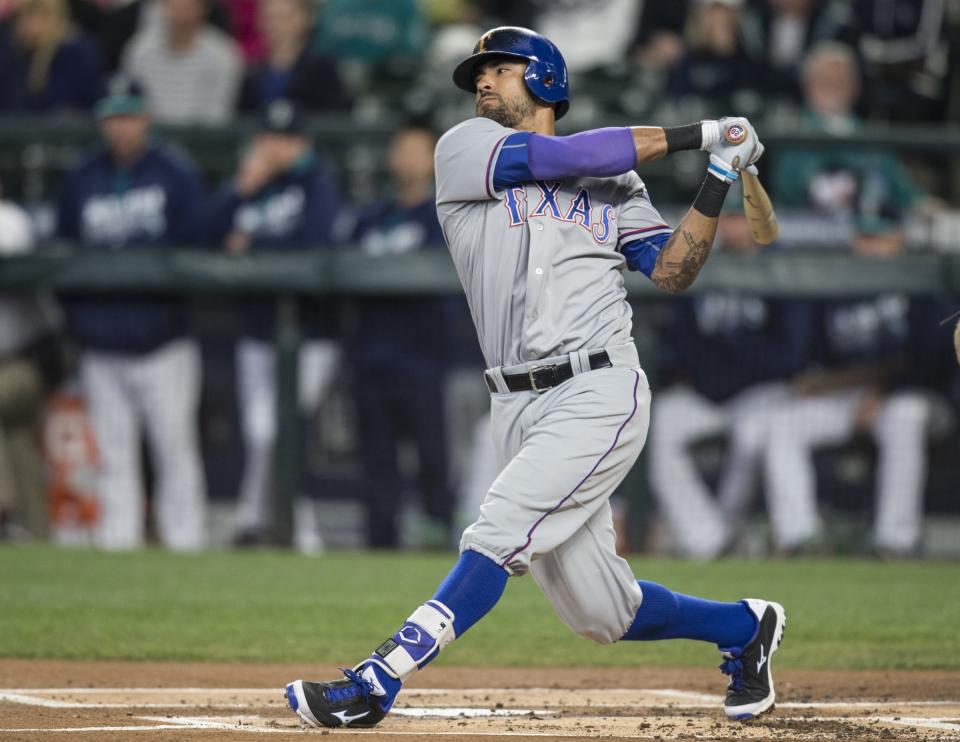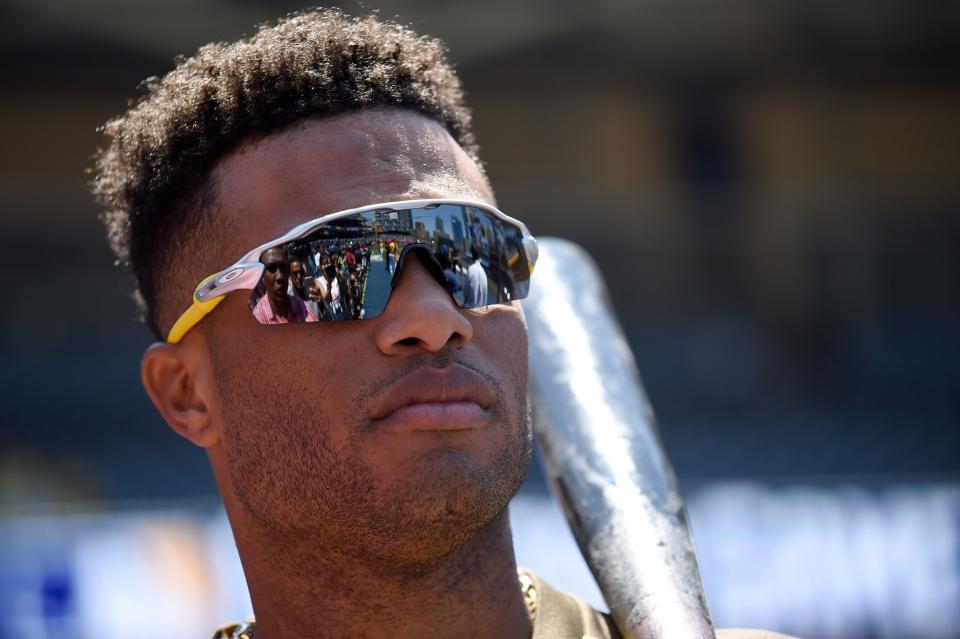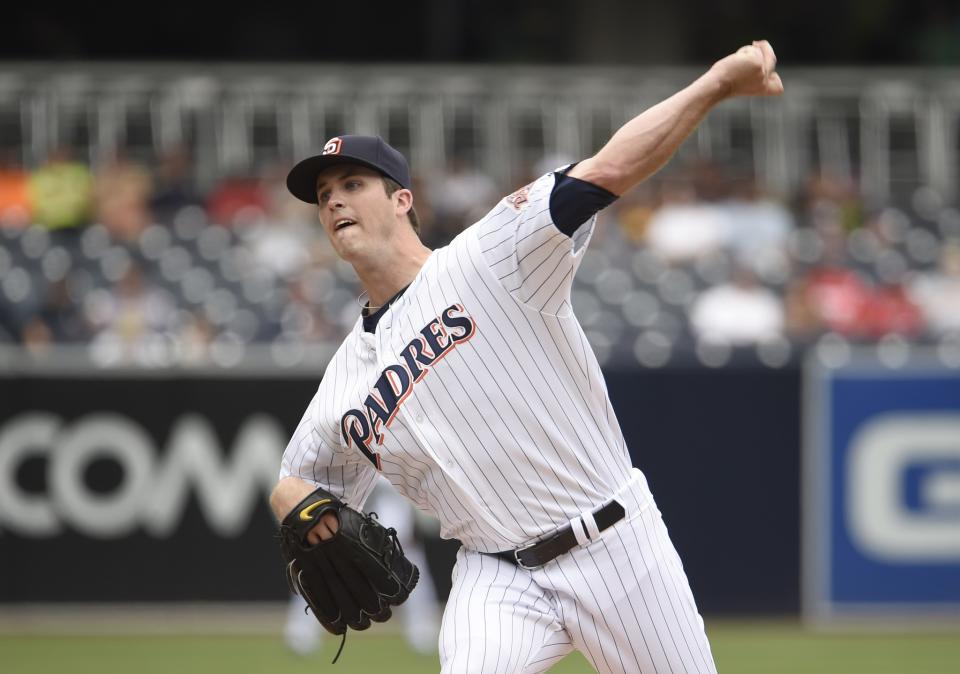Ian Desmond's outfield transformation is MLB's best comeback tale

SAN DIEGO – When his career asked to veer into a strange place he’d not been, when he’d played himself into this strange place pretty much by mistake, Ian Desmond sought clarity from those who’d already passed through. He was 30 years old. He was a shortstop. He was without a team. And he was running out of options.
The Texas Rangers had told him he could come there, to Arlington, but they had their shortstop. They had told him he could come be an outfielder, which is not unlike being a shortstop in that both players generally stand on the same baseball field and face a similar direction.
Desmond, in the view of many, had played himself off shortstop because of those 27 errors the year before, and had played himself to the back end of free agency because of that .233 batting average and .290 on-base percentage the year before. Desmond’s path back to a big-league lineup, he understood, might not be chosen entirely by him.
So maybe he could be an outfielder, get a decent job on a division winner, end his winter of waiting and confusion, and get on with baseball at 30. But could he be an outfielder?
He called Rick Ankiel, who’d once tramped from the pitcher’s mound to the outfield. He called Jayson Werth, who’d begun his career as a catcher. He called Mark DeRosa, who, over 16 big-league seasons, played at least 140 games at shortstop, right field, second base and third base. He called Steve Lombardozzi, who across five major league seasons squeezed in four positions – second base, third base, shortstop and left field.
“Hey,” he told them, “this is what I’m thinking. I think this is what I want to do. Talk me out of it.”
On Monday afternoon, sitting at a podium beneath a sign that said this here was outfielder Ian Desmond, American League All-Star, Desmond raised his eyebrows and smiled.
“And nobody tried,” he said. “Nobody tried.”
The guy with the rose tattoo on his left forearm, with the Technicolor wedding band, with the sprouts of gray in his hair, had – one fungoed ball at a time, one first step at a time, one read off the bat at a time, one decent path to the ball at a time – become a very capable outfielder and a wonderful story of self-belief and a good reason the Rangers are leading the AL West again. As not only has Desmond handled the glove side proficiently, and not only did that left-field experiment become a center-field experience, he arrived in early July with a .322 batting average, a .375 on-base percentage, 15 home runs and 55 RBI.
Yeah, baseball’s baseball until you’re crouched all alone in center field with the bases loaded and one out in an early-evening gloom and that top-spinned line drive looks like it might fall in – but wait – maybe it’s carrying and why is everyone screaming so loud?
Desmond, long one of the more thoughtful and approachable players in the game, is having his comeback season. That he had to leave Washington and his lifetime position to do it, while burdened by the yoke of qualifying offer and unevenly played walk year, made for an interesting watch and an unqualified success.
“From the very beginning, I thought this place is going to bring out the best in me,” he said of Texas and the Rangers. “The individual stuff, I don’t feel a sense of satisfaction. I’ve got my eyes much further down the road.”
A WEEK BEHIND:

Robinson Cano arrived at the break with a .313 batting average, .923 OPS, 21 home runs and 58 RBI. A few more months like that, he’ll have had the best season of his career, in his third with the Mariners.
It wasn’t that long ago when Cano – an injured Cano – was considered to be flopping in Seattle and hating it there, which he never said, which did not quell the speculation.
“Love it,” he said. “I really love it and I have fun. People were saying I wasn’t having any fun because I wasn’t doing any good.”
Here he offered a crooked grin.
“I wonder,” he said, “what they’re going to say now.”
A WEEK AHEAD:
Teetering to languid for a couple months and admittedly gassed near the end of the first half, the Cubs get three against the Rangers and three against the Mets out of the second-half gate.
The Cubs were swept in a four-game series in New York two weeks ago. The more intriguing series, however, will be that against the Rangers, who, like the Cubs, bogged down in early July.
While the Cubs were losing nine of 11 and giving some of their massive NL Central lead back, the Rangers were losing nine of 12 and kicking back 4 ½ games to the Astros in the AL West.
Rangers pitchers allowed 98 runs in those 11 games, an average of nearly nine a game. That’s the sort of pitching that’ll have a club longing for four days off. Cole Hamels allowed 10 runs in 8 1/3 innings over two starts to conclude the first half, with fellow starters Yu Darvish, Derek Holland and Colby Lewis on the disabled list. Darvish returned from Tommy John surgery, made three starts, then returned to the DL because of a sore right shoulder.
SAW IT COMING:
Home runs have spiked and commissioner Rob Manfred has assured everyone the baseballs are not juiced. He also reasoned that if the power increase were due to a new strain of undetectable PED, it likely would arrive at the start of the season, when dirty players would have an offseason to get, you know, stronger.
So, what gives?
One theory: fastball velocities are up and therefore travel farther when struck by a bat. (Course, now we have to figure out why fastball velocities are up. Anyway …)
“That’s science,” Blue Jays slugger Josh Donaldson noted.
“It’s taken hitters time to adjust to the velocity,” he said. “If you see 96 every day, 96 slows down.”
DIDN’T SEE IT COMING:

Drew Pomeranz, the kick-around starter/reliever left-hander with the 4.07 ERA for the Rockies and A’s for five years, had a 2.47 ERA and 10.1 strikeouts-per-nine in his first half-season with the Padres. As surprise All-Stars go, Pomeranz was there with the biggest of them, and for that he would credit the return of a unique curveball taught to him by his father. Drew was 10 at the time.
Maybe not entirely unique. Drew’s brother, the former big leaguer Stu Pomeranz, threw his the same way. As far as Drew knows, they’re the only two.
“It’s not traditional,” he said Tuesday afternoon. “I kinda flick it forward.”
Rather than torque his wrist and elbow to generate the spin that causes the ball to curve, Drew tucks his forefinger under the ball, throws it like a fastball, and just before the release extends his forefinger. Imagine sneaking up behind your little brother and snapping his ear. Same thing. The topspin changes the flight of the ball (and the ear), which acts like a curveball.
He has thrown that curveball nearly 40 percent of the time, nearly as often as he does his fastball. As a result Pomeranz’s ERA ranks behind only Clayton Kershaw’s, Madison Bumgarner’s and Johnny Cueto’s in the National League, and he very well could be traded into a pennant race in the next few weeks.
“It disappeared for a couple years in Colorado for whatever reason,” he said. “And now I’m throwing it better than I ever have.”


